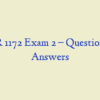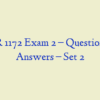Description
PHY 1301 Final Exam – Question and Answers
- In the International System of Units, length is measured using which of the following units?
- Which of the following units is not an SI base unit?
- If the mass of a vehicle is 100 kg, what is the weight of the vehicle on Earth? The acceleration due to gravity on Earth is 9.8 m/s2.
- Which one of the following forces is considered a fundamental force?
- The initial kinetic energy in a system was 0 J, and the initial potential energy was 500 J. If the final kinetic energy is measured as 500 J, what is the final potential energy of the system? Ignore frictions.
- If a satellite orbits Earth in a uniform circular motion, what is the direction of the centripetal acceleration of the satellite?
- A boy exerts an average force of 100 N on a toy cart for 0.7 seconds. What is the impulse?
- A girl exerts an average force of 50 N on a toy cart for 0.5 seconds. What is the impulse?
- A spring has a spring constant of 100 N / m. Find the magnitude of the force needed to compress the spring by 0.1 m.
- A spring has a spring constant of 10 N / m. Find the magnitude of the force needed to compress the spring by 0.1 m.
- The pressure acting on a floating piece of wood is measured by 1000 Pascals, and its surface area is 0.01m2 . What is the magnitude of the force in Newtons?
- Which one of the following is the coldest temperature?
- Which one of the following variables is the best indicator of thermal equilibrium between two systems in thermal contact?
- Which one of the following is not a correct description of Stefan-Boltzmann’s law?
- Which one of the following is not a correct description of ideal gas law?
- Consider an isobaric expansion of a substance in a laboratory. The constant pressure is measured as 20,000 Pascal. The initial volume of the substance is 0.001 m3 , and the final volume of the substance is 0.01 m3 . Calculate the work done through this process.
- A system does 100 J of work to its surroundings and gains 50 J of heat in the process. Calculate the change in the internal energy of the system. Determine if the internal energy is increased or decreased during the process.





